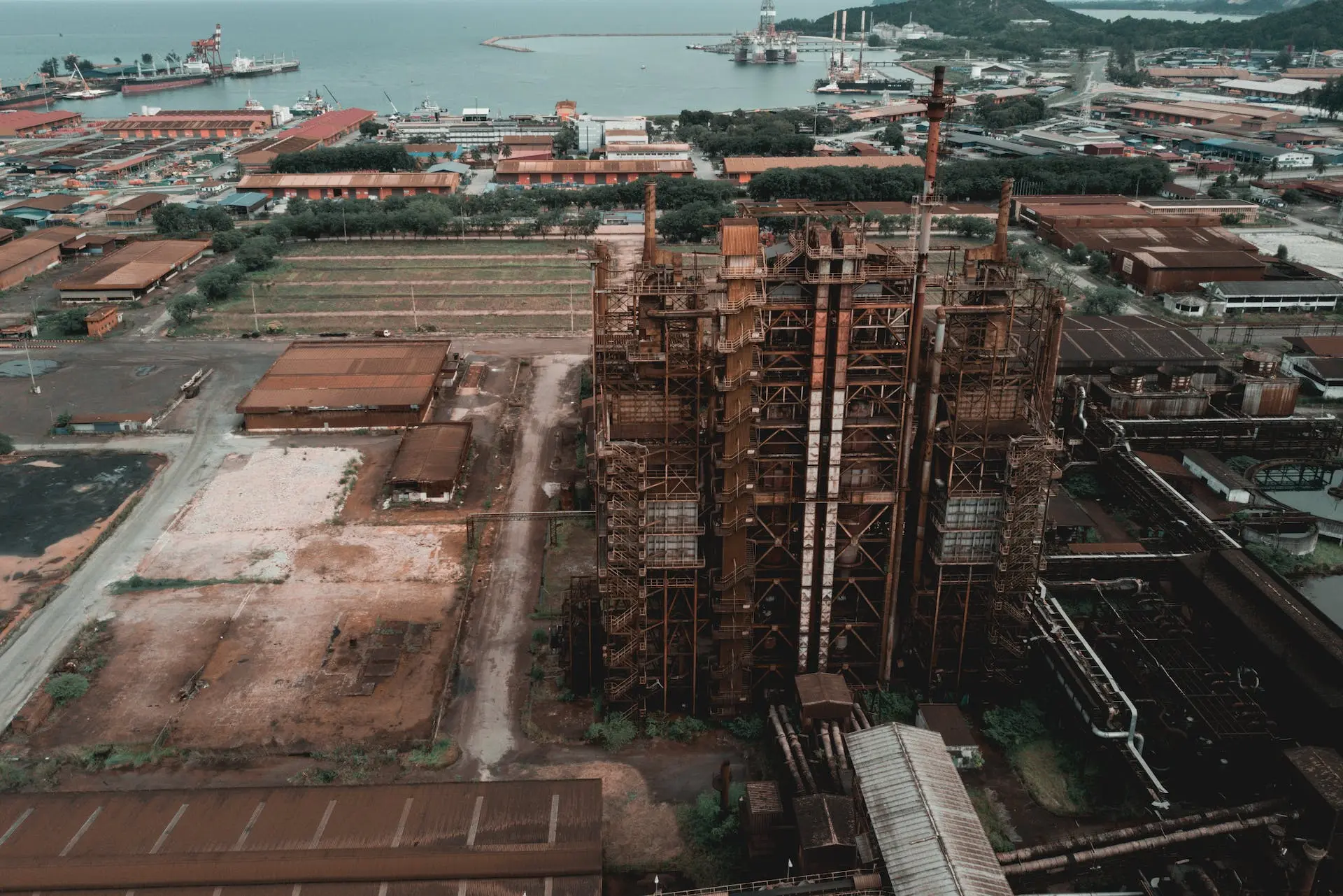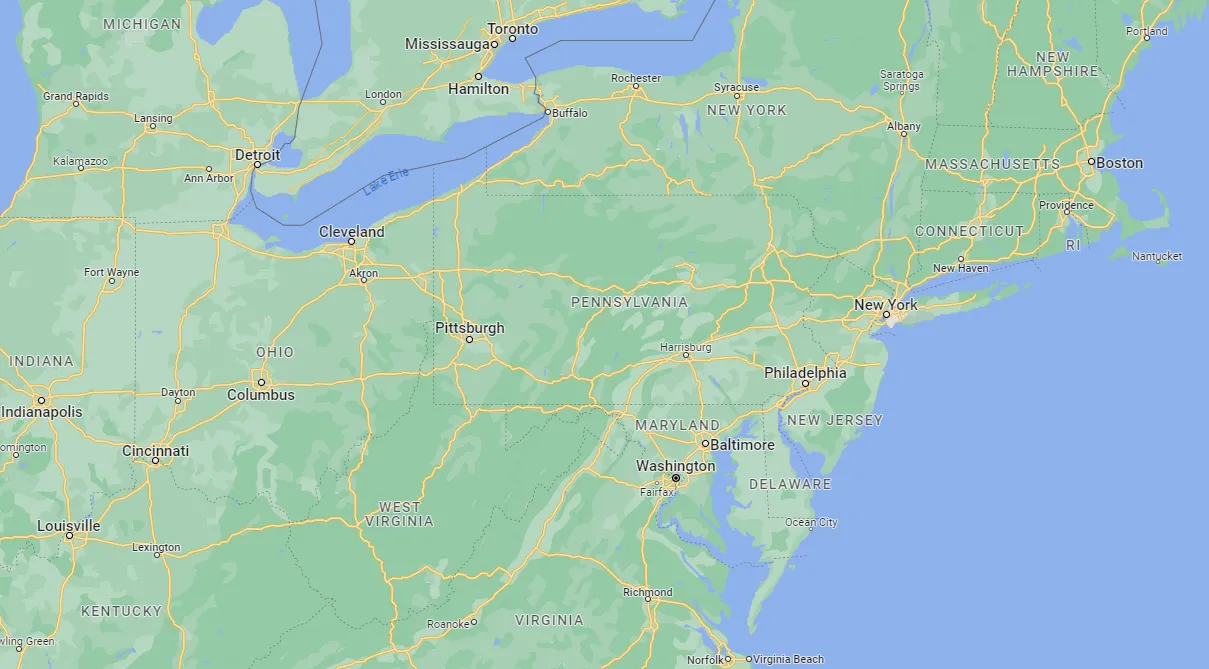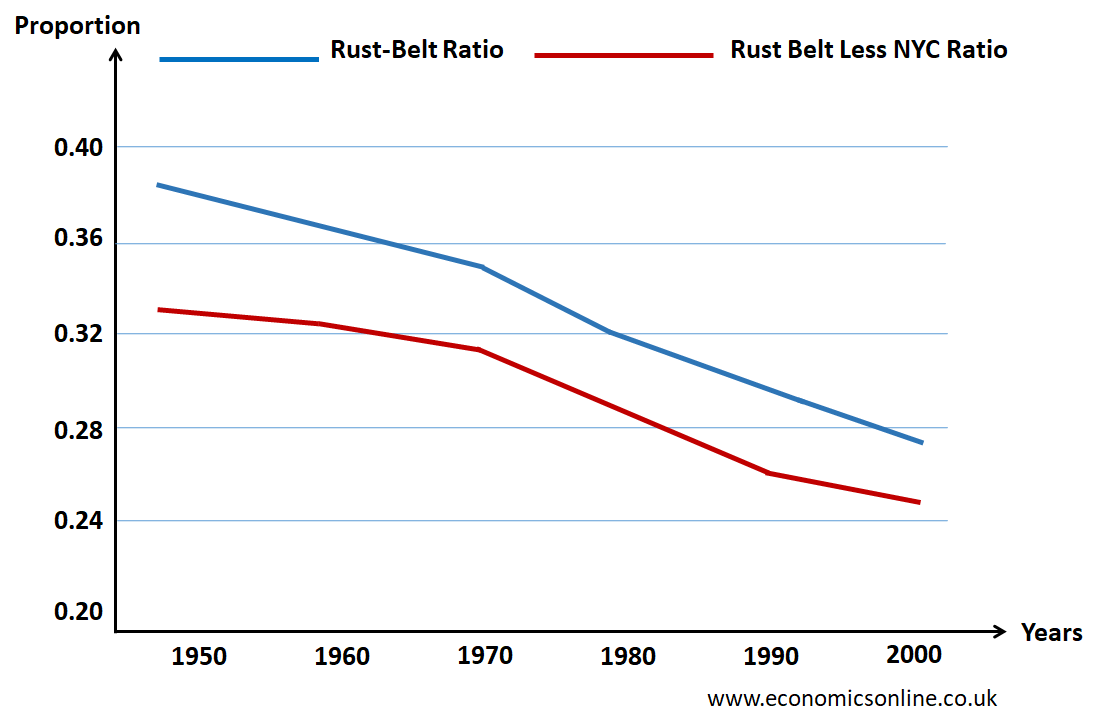
An image of a rusted iron plate and knot.
What is the Rust Belt?
Introduction
The rust belt refers to a region in the US that experienced a decline in industrial activity after the 1950s. Some states are included in the US rust belt, such as Michigan, Ohio, and Pennsylvania. These regions were given the name of the rust belt in the late 1970s.
In general, a rust belt can be defined as any area that faced declining industrial activity in the 1980s. For instance, north-east England, Scotland, and north-east England experienced a decline in industrial activity in the 1980s.
However, mostly, the rust belt refers to the mid-west of the US.
The areas in the rust belt faced increasing structural unemployment, decreasing incomes, a decreasing region’s population, and increasing social problems.
Historical Background
The rust belt has its roots dating back to the Industrial Revolution. It was once a flourishing centre of manufacturing industries. These industries used natural resources for their manufacturing. The cities included in the rust belt were Pittsburgh, Detroit, and Cleveland, which were hubs for the steel and automotive industries.

Then, at the start of the mid-20th century, those cities faced serious economic challenges due to the decline in economic activities in the U.S. Some factors, such as globalisation, automation, and the change in consumer preferences, caused a serious economic decline in the manufacturing industry. Many factories closed due to these factors, which led to job losses and population declines in some regions.
But the rust belt has been transforming these years. Those cities that faced decline are now diversifying their economies by focusing on sectors such as healthcare, technology, etc.
The US Rust Belt
The rust belt in America extends from western New York to the Midwest, encompassing states around the Great Lakes such as Pennsylvania, Missouri, West Virginia, Chicago, Baltimore, Maryland, Ohio, Indiana, and the Lower Peninsula of Michigan. It concludes in northern Illinois, eastern Iowa, and southeastern Wisconsin.

Historically, during the 20th century, this geographical area was recognised as the manufacturing hub of the United States. It held a significant population and played a crucial role in large-scale manufacturing, specifically in industries such as steel, coal, and general manufacturing.
Causes of the Rust Belt
The following factors caused rust belts, which are explained as follows:
Globalization and Outsourcing
Companies shifting production to countries with lower labor costs affected the region's industries and led to job losses.
De-industrialisation
Deindustrialization means a decline in the manufacturing sector of the economy and is a major cause of the rust belt.
Technological Advancements and Automation
Increased automation reduces the need for manual labor, resulting in fewer manufacturing jobs.
Changing Consumer Preferences
Shifts in consumer demand towards fuel-efficient vehicles and imported goods impacted industries like steel and automotive.
Global Competition
Increased competition from overseas producers made it challenging for rust belt industries to remain competitive.
Change in Comparative Advantage
The areas of rust belt saw a declining industrial activity due to the shift in comparative advantage from labor-intensive production to capital intensive production in which some Asian countries were having lower opportunity costs.
Economic Restructuring
The region's heavy reliance on traditional manufacturing industries made it vulnerable to economic shifts and changes in market demands.
Globalisation and the Rust Belt
Globalisation has a powerful impact on the rust belt. With globalisation, countries began to outsource manufacturing to other countries with low labor costs. Due to this, many factories in this region shut down. This led to job losses and a decrease in economic growth in those areas or regions that were once the major industrial centers. Globalisation led to increased competition between overseas manufacturers, which caused local manufacturers or small industries to remain in competition.
Steel Belt
The word “steel belt” originated from the plenty of steel mills and factories in a specific area or region. The decline in the steel industry, which led to a serious downfall in the economy, is known as the Steel Belt. The Steel Belt explains the decline in the steel industry, which led to economic challenges. The steel belt refers to the northeastern and mid-western regions of the United States that are famous for their steel manufacturing industry.
Sun Belt
The sun belt refers to the southern and southwestern regions of the United States that are known for their rapid population growth and favorable climate. States such as Arizona, Mississippi, Florida, and Texas are included in the Sun Belt. These regions experienced high economic and demographic growth, attracting individuals and businesses due to their suitable weather, low living expenses, and greater job opportunities in different industries such as tourism, healthcare, and technology.
Proportion of the U.S. Population
The following graph shows the proportion of the U.S. population residing in rust belt states such as Ohio, Pennsylvania, and New York City from 1950 to 2000.

In the above graph, we have years on the x-axis and the proportion of the population on the y-axis. In 1950, the blue curve shows the rust belt including New York City, which is 38% of the U.S. population, and the red curve shows the rust belt excluding New York City, which is 33% without it. At 2000, the rust belt’s proportion had fallen to 28% and 25%.
Importance of the Rust Belt
The following points explain the significance or importance of the rust belt:
Industrial Heritage
The industrial heritage has great importance in the rust belt as it serves as a prosperous hub for manufacturing and innovation in sectors such as steel, automobiles, and machinery, etc.
Job Creation
The rust belt regions provide job opportunities for millions of workers who are supporting their families and also contributing to the overall economic growth of the country.
Economic Impact
The economic impact of the rust belt can be seen in industries that enhance the country’s revenue and also contribute to the national GDP, making it a major part of the U.S. economy.
Innovation and Research
The region was home to numerous research institutions, universities, and technological advancements, fostering innovation and driving progress in various fields.
Cultural Identity
The rust belt holds a unique cultural identity shaped by its industrial history, blue-collar work ethic, and the resilience of its communities.
Poverty and the Rust Belt
The following points show the effects of poverty on the rust belt:
Economic Decline
Poverty can cause serious economic decline by reducing job opportunities or job losses. This situation has become challenging for many communities to stimulate economic growth.
Job Losses
Poverty in a country can cause a decline in industries like manufacturing and steel; this will result in job losses, which cause a high poverty rate in some regions of that country.
Limited Opportunities
The decline in traditional industries such as manufacturing and steel can cause limited job opportunities and make it difficult for individuals to escape poverty and find a stable job.
Community Impact
Communities are also negatively affected by poverty, as people are less likely to access education preferring their children to earn money. This will increase child labor in the country. Poverty also affects healthcare and other services in the country.
Political Impact on the Rust Belt
The following points explain the impact of politics on the rust belt:
Shifting Voter Demographics
Voter preferences can shift due to economic challenges and changing demographics. It also affects the political dynamics in that particular region of a country.
Trade and Manufacturing Policies
Political decisions on trade agreements and manufacturing policies can have a significant impact on the rust belt, as these industries have been central to the region's economy. Changes in policies can affect job prospects and economic stability.
Job Creation and Infrastructure
Political initiatives aimed at job creation and infrastructure development can directly impact the rust belt, providing opportunities for economic growth and revitalisation.
Social Programs and Safety Nets
Political decisions regarding social programs and safety nets can play a role in addressing poverty and inequality in the rust belt, providing support to individuals and families facing economic challenges.
Political Representation
The impact of political parties on the rust belt in terms of representation is that those parties elected work for the welfare of the region by investing in infrastructure or other welfare programs to satisfy the communities.
Impact of COVID-19 on the Rust Belt
The following points explain the impact of COVID-19 on the rust belt:
Economic Disruption
During the pandemic, there was a great decline in the region’s economy, as it caused major job losses, business closures, and also financial challenges for communities in that region.
Manufacturing Slowdown
The manufacturing slowdown is a major impact of COVID-19, as the rust belt’s manufacturing sector is a major contributor to the region’s economy, but it affected the supply chain and lowered the demand for products and services.
Unemployment and Financial Strain
The pandemic-induced economic downturn has resulted in increased unemployment rates and financial strain in the rust belt, as many individuals and families have faced job losses and reduced income.
Small Business Impact
Small businesses, which are the backbone of many rust belt communities, have been particularly affected by COVID-19 restrictions and closures, leading to closures and the loss of livelihoods.
Recovery Efforts
To support the recovery of rust belt from the pandemic COVID-19 by making efforts such as government support programs and supporting individuals and businesses to rise back.
Development of the Industrial Sectors
The following points show development in the industrial sectors:
Rise of Manufacturing
The development of the industrial sector can be influenced by the rise of the manufacturing and steel industries, including in states such as Michigan, Ohio, and Pennsylvania. These states faced a great decline in the manufacturing industry.
Steel and Automobile Industries
The region became known for its steel production and automobile manufacturing, with cities like Pittsburgh and Detroit at the forefront.
Economic Decline
There is a need to overcome the threat of economic decline because globalisation and automation caused a great decline in industrial sectors by reducing job opportunities and factory closures.
Shift to Service Sector
Many cities in the rust belt have transitioned to a service-based economy, focusing on sectors like healthcare, education, and technology.
Revitalisation Efforts
The revitalisation efforts have been made to develop the industrial sectors, such as by investing in infrastructure, innovation, and sustaining new businesses.
Conclusion
In conclusion, the rust belt shows an economic decline in industrial sectors such as manufacturing and the steel industry. While it faced challenges and economic decline, there have been ongoing efforts to revitalize the region. The transition to a service-based economy and investments in infrastructure and innovation show a commitment to adapt and create new opportunities.

